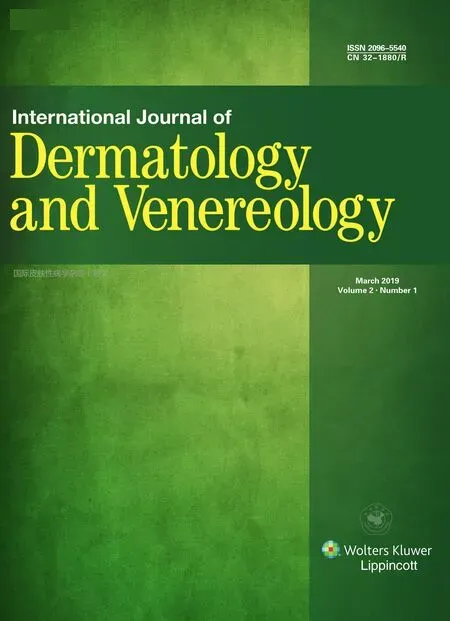Cutaneous plexiform schwannoma in the right thigh after trauma
Ying Li,Chao-Yang Miao,Chen Wang,Xiao-Yan Zhang*
1Peking University China-Japan Friendship School of Clinical Medicine,Beijing 100029,China. 2Department of Dermatology,China-Japan Friendship Hospital,Beijing 100029,China.
Introduction
Plexiform schwannoma accounts for approximately 2%-5%of schwannoma.It often afflicts young adults,affecting males and females at a similar rate,and is most commonly located in the head,neck,trunk,or upper extremities.Plexiform schwannoma occasionally occur in the foot,but are rarely found in the lower limbs[1].The tumor usually presents as a solitary,slow-growing,asymptomatic nodule,and the maximum diameter of plexiform schwannomas is less than 2 cm[2].Trauma-related plexiform schwannoma is rare and needs to be differentiated in clinic.Herein,we report an unusual case of 28-year-old women with a reddish-brown plaque of her right thigh accompanying tenderness,the patient had been injured in the same location where the plaque later developed,and the histopathological results were consistent with plexiform schwannoma.
Case report
A28-year-old female patient presented with a plaqueon on her right thigh for more than 10 years.Over a decade ago,the patient had noticed a nodule about the size of 1 cm on her right thigh.At that time,it was slightly tender,and enlarged slowly over the years.There were no similar lesions on other parts of her body.When she was 6 years old,the patient had been injured in the same location where the plaque later developed.There was no family history of plexiform schwannoma.
Dermatological examination showed presentation of tumor on the inside of the patient’s right thigh as a medium-sized,reddish-brown plaque with a welldefined boundary(Figure 1A).The lesion was 2 cm×3 cm,with granular sensation.The lesion had slightly upheaved the skin surface,and was tender in response to palpation.A histopathological examination revealed irregular thickening of the epidermis spinous layer,increased pigment of the basal lamina,and multinodular well-defined tumor masses in the dermis and subcutaneous tissues.The masses were surrounded by a fibrous capsule and composed of spindle cells with hyperchromatic nuclei.Nuclear atypia was observed,but there were no pathological nuclear mitotic figures(Figure 1B -1D).Immunohistochemical staining showed the following patterns:S-100(+),Ki67(<1%+),EMA(focal+),vimentin(+),α-SMA(?),and NF(?)(Figure 1E).Based on the above findings,a diagnosis of plexiform schwannoma was made.The patient refused to undergo surgical resection,so we advised follow-up for her in our out-patient clinic.By the writing time,there is no significant change in skin lesions during follow-up.
Discussion
Plexiform schwannoma is a rare variant of schwannoma,and there are fewer than ten case reports describing this tumor type in the lower limbs[3-7].Although trauma may play a role in the formation of schwannoma[1,8],the case of cutaneous plexiform schwannoma caused by trauma are rarely reported.Upon diagnosis,the skin lesion was more than 2 cm large.Histopathological examination showed multiple intradermal or subcutaneous nodules,mainly composed of cellular Antoni type A regions in which there were palisading nuclear and Verocay bodies.Immunohistochemical staining revealed that S-100 protein and vimentin were detected diffusely,whereas desmin was not detected.Several cases of cutaneous plexiform schwannoma have been accompanied by neurofibromatosis type Ⅰ,and a few cases may have been associated with neurofibromatosis type Ⅱ,schwannomatosis,or meningioma.The diagnosis of plexiform schwannoma needs to be made based on biopsy results,which can help to distinguish it from plexiform neurofibroma,plexiform fibrous histiocytoma,and nerve sheath myxoma.

Figure 1 Clincial image and histopathological results.A medium-sized,reddish-brown plaque with a well-defined boundary on the inside of the patient’s right thigh.B:multi-nodular well-defined tumor masses in the dermis and subcutaneous tissue(H&E,× 10).C:The masses of tumor tissue were surrounded by a fibrous capsuleand composed of spindle cells with hyperchromatic nuclei in the dermal and subcutaneous areas(H&E,× 40).D:Nuclear atypia was clearly observed,but there were no pathological nuclear mitotic figures(H&E,× 100).E:Immuno-histochemical staining showed Vimentin(+)(×100).
In conclusion,plexiform schwannoma is a benign peripheral nerve sheath tumor particularly associated with neurofibromatosis,and the prevalence of recurring tumors after their complete removal is rare(2%).The histopathological and immunohistochemical findings of this patient provided conclusive evidence for a diagnosis of solitary plexiform schwannoma,and our case was associated with the history of local trauma.The case helps to improve the understanding of plexiform Schwannoma.
- 國際皮膚性病學(xué)雜志的其它文章
- Paraneoplastic pemphigus comorbid with cardiac cancer and duodenal gastrointestinal stromal tumors:a rare case report
- Reactive perforating collagenosis
- Sun?protection knowledge and strategies of Chinese dermatologists:a nation?wide,questionnaire?based survey
- Initial presentation of acute myeloid leukemia in a patient with cutaneous myeloid sarcoma
- Persistent papules with adult?onset Still’s disease:a case report
- Primary vulvar melanoma in a 27?year?old pregnant woman:a case report and literature review

